Reviewed by Glenn Erickson
Modern pop music, including the music for most newer Broadway shows, shows a painful lack of something that America once created in enormous quantities: melodies. Although the generation that most loved the Rodgers & Hammerstein musicals is well on its way to passing on, the popularity of those shows is still very strong. As a kid of the fifties, I can attest to the fact that the music of the shows in Fox's new Blu-ray set The Rodgers & Hammerstein Collection all became a part of our DNA. Oklahoma! was one of the first movies I ever saw, probably at age 4. Across the years our family collected 45 rpm record sets, LPs and eventually various videos of some of these pictures. They were core family viewing, and I can remember my mother's pleased reaction to our 'shared experience' with them.
The critical literature we read later in film school had little use for these movie versions, which were not considered to be particularly good cinema. Movies that delve into the musical possibilities of movies, like for instance Rouben Mamoulian's Love Me Tonight, make some of the R&H adaptations seem like lazy pageants only a couple of notches above the operetta spectacles that flourished at the beginning of the sound era. Despite this, two of the R&H pictures are bona-fide classics, and all of them have memorable and sometimes inspirational moments. Even when things get thin, there's always the music -- a body of songs not likely to be forgotten.
The six pictures have collected complex production and ownership histories, but all have stayed together under the Fox banner. This is a good thing, as only a studio with full facilities could properly care for the myriad film and audio elements associated with the films, all but one of which was produced in a large-screen format. The movies in the set are State Fair, Oklahoma!, Carousel, The King & I, South Pacific and The Sound of Music. Only two have had previous Blu-ray releases; these are presented with the same transfers -- but not all of the same extras. I've written previous reviews for four of the pictures, so instead of recapitulating those discussions I've linked to earlier Savant reviews. That will give me more space here to write about transfer quality and the interesting film formats employed, with a little space left over to note the extras.
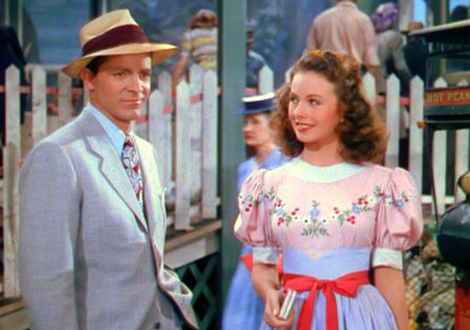
State Fair was released by Fox in a 60th Anniversary Edition DVD in 2005. DVD Savant's previous review is here.
Although not one of the 'super-productions' that would follow a decade later, State Fair is a sweet, quaint musicalization of a novel previously produced as a non-musical film in 1933. Fox gave it the full Technicolor treatment, along with the top singing talent Dick Haymes and Vivian Blaine. Jeanne Crain and Dana Andrews are dubbed. Curiously, Andrews began his show business career as a singer but repeatedly declined to sing, as he wanted to be regarded as a serious actor only. After all, Dick Powell had recently succeeded in switching from crooning to straight drama; going the other way was not considered a smart career move.
The HD transfer is in great shape and has the candy-color look of Fox musicals of the '40s. It isn't as sharp as one might expect, but there's definitely more detail present than on the older DVD. The mono audio is strong if obviously not as dynamic as that on the newer pictures. The songs "It Might as Well Be Spring" and It's a Grand Night for Singing" made the biggest impact with this viewer. The attractive Jeanne Crain and Dana Andrews are plunked down in the middle of a storyline that relentlessly celebrates the joys of rural life. Sorry, most Iowans all went to the big city like everyone else.
State Fair has the fewest extras. All of the titles offer the viewer four ways to watch the film. One can play the picture straight through or play it in "Music Machine" mode, which skips from song highlight to song highlight. There's also the "Sing Along" mode, which adds lyric subtitles to the songs. Finally, "Play (whole) Film with Sing Along" is self-explanatory.
Between the commentaries and the extras on the discs, one can get a solid, and sometimes fairly critical, overview of their origins in books or the stage and the way the films came together. The commentary on State Fair is by authors Richard Barrios and Tom Briggs. The half-hour docu From Page To Screen To Stage charts the musical's 'backwards' genesis -- it was a movie musical first before being adapted to the stage.
Each disc also contains a wealth of visual extras in Still Galleries: often broken down into categories of ad art, behind-the-scenes stills and production stills showing sets, costumes, etc.
The one thing missing here that was included on the DVD presentation is the 1962 State Fair remake with Pat Boone and Ann-Margret. It's nobody's idea of a good movie, from any angle... but it did have Bobby Darin, and that's kind of fun.
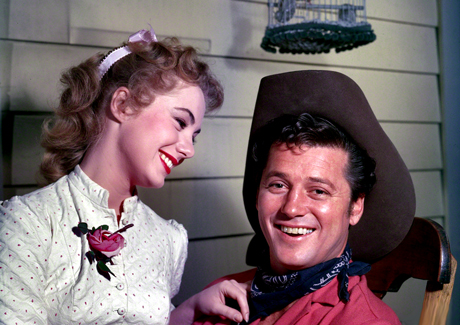
Savant wrote up a storm for the 2005 DVD release of Oklahoma!, and that previous review can be read here. The movie drags at times and some of the direction is dull, but many of the musical sequences are brilliantly done. The main central ballet motivated by Shirley Jones' song "Out of My Dreams" is a marvelous mix of great choreography, staging and direction - its stylized painted sky backdrops look like something from the Japanese movie Kwaidan. Song for song, Oklahoma! has possibly the most memorable music of the features in this set. Seen in a good presentation, it's a powerful show.
Mike Todd pulled out of Cinerama and made Oklahoma! as what was to be the first film of a Road Show feature empire. The movie invented its own Todd-A0 (American Optical) film format. The process and the movie were practically developed together. 65mm wide and five perfs tall, Todd-AO also ran at 30 frames per second, to cut down on strobing, flicker and 'chatter' during on-screen motion. Todd-A0 could not be adapted for normal 24fps theater use, so Mike Todd was forced to simultaneously film a second standard CinemaScope version of the film. That second version is what had been seen almost exclusively since the late 1950s.
The biggest news of this new Blu-ray set is that the 30-frame Todd-AO version of Oklahoma! is back, this time looking and sounding sensational. The 2005 DVD was something of a disaster for R&H fans. It contained both versions, but the Todd-A0 transfer was of awful quality -- blurry and diffuse, it looked like mush. Things went seriously wrong: IPs made from YCM protection sources didn't turn out well but were used anyway. Now, ten years later, scanners are so safe that the original neg for Oklahoma! could be scanned, and the result is magnificent.
The Todd-A0 version was reportedly filmed first and its cameras occupied the best positions. It has been suggested that the quality of the daylight looks better and some of the performances seem fresher in the Todd-AO version, too. The cutting and framing differs between versions, and the Todd-AO cut is eight minutes longer. This disc may be the deal-maker that sells a lot of these boxed sets, although I must add that a stand-alone Oklahoma! is rumored to be out within a year or so.
The Todd-AO and CinemaScope versions occupy separate discs. The CinemaScope version looks good too, but is nowhere near as impressive. Both versions have excellent multi-track audio, and the Todd-AO listed as a DTS-HD master audio 7.1 track.
Beyond the four playback options and galleries/trailers, Oklahoma! is graced with two commentaries (Shirley Jones/Nick Redman; Ted Chapin/Hugh Fordin), featurettes comparing the two format versions, and the development of Todd-A0. Culled from a 1950s TV show are two song excerpts from the show, sung by Gordon MacRae and -- wait for it -- Florence Henderson. She's very good!
Master producer Mike Todd pulled together resources that historically didn't mesh well -- Hollywood, Broadway and the research/technical industry. For a year or so it seemed possible that the 'new' Hollywood might convert to Todd-AO for road shows, with a change to 30fps becoming normal even for standard films. As it happened, the industry would instead slowly lose interest in expensive 65mm 'big pictures'.
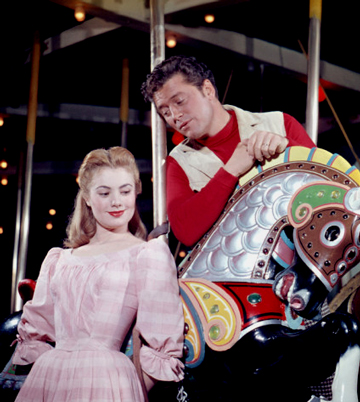
Carousel was also released in 1955. As every studio wanted its own proprietary format, Fox came up with a king-sized CinemaScope system called CinemaScope 55, using an enormous negative withan anamorphic squeeze identical to standard 35mm CinemaScope. When the executives saw the improved quality of print-downs to 35mm 'Scope, they abandoned plans for large-format projection, just as Paramount had with their own proprietary VistaVision. Carousel and The King and I were the only films shot in CinemaScope 55.
Carousel is the most problematic of the R&H features. Although it has some of the series' most beautiful songs, it is the least original and the least exciting visually. The repeat casting of Shirley Jones and Gordon MacRae might seem a quickie follow-up to the previous show, but in actuality, Frank Sinatra walked off the movie when he discovered that he'd have to shoot all of his scenes twice for the CinemaScope 55 and 35 versions (The 35mm version was abandoned during filming). Director Henry King seems defeated by a production that wastes beautiful New England locations by using them as static backdrops. Not helping are uninspired sets back in Hollywood sound stages that often simply look cheap. After an uninspiring prologue in a smoke & glass 'heaven', the first earthbound scene is a marvelous, more or less dialogue-free story setup that brings together innocent factory girl Julie Jordan (Shirley Jones) and carousel barker Billy Bigelow (Gordon MacRae). Billy's boss Mrs.Mullin (Audrey Christie, so good in Splendor in the Grass) insults Julie and fires Billy over a flirting incident, while the marvelous main "Carousel Waltz" theme reinforces the notion that an unquenchable love has been ignited.
From that point forward Carousel is directed as if on remote control, with barely a thought given to anything beyond setting up the (great) songs. The plotline slogs along like a can kicked down the road. It's best to concentrate on the quality of the musical arrangements and their delivery by the capable cast. Julie loses her job as well, marries Billy and becomes pregnant. Egged on by his thuggish false friend Jigger Craigin (Cameron Mitchell), the chronically irresponsible Billy goes through with a stupid robbery. Tragedy ensues. Sixteen years later in heaven, a film blanc miracle allows Billy to return briefly to Earth to try to do one good thing for the daughter he never knew (Susan Luckey). The ending is a bittersweet tearjerker that verges on the maudlin. Although Billy Bigelow barely showed his love for Julie, their problem seems to have been only a matter of bad communication. He's really a softie enchanted by the idea of having a child. One idea carried over from the source play, is that wife beating can be a matter of "hits that don't hurt". In this context, it's a painfully dated embarrassment not likely to be appreciated by activists against domestic violence. I can imagine the horror of a battered wife who sought some psychic relief and chose to attend a 1955 matinee of Carousel. Although Billy and Julie's life is one big botch based on Love At First Sight, the message is that it's okay because "You'll Never Walk Alone".
Added to this are a couple of New England- flavored songs based on stonecutting and clambakes. Not helping to advance the central theme is an insipid 'comic' alternative to the floppo Bigelow marriage. Dopey dame Carrie Pipperidge (Barbara Ruick) stays on the straight 'n' narrow, marries her dull goofball swain Enoch Snow (Robert Rounseville) and lives a cookie cutter life with a baker's dozen of kids. This is no fault of the players. Barbara Ruick is adorable and sings her song "When the Children are Asleep /When I Marry Mr. Snow" in a way that breaks one's heart. All the yearnings of matrimonial romance are in there; Ms. Ruick surely sent 1,000 young men running to propose to their girlfriends.
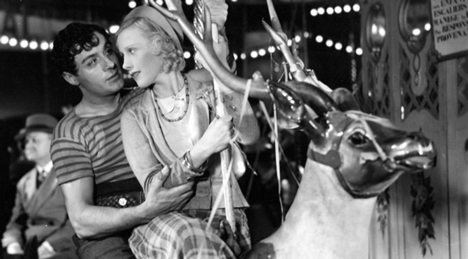
Prominent among the extras for Carousel is a carryover from the DVD special edition, the 1934 film Liliom directed by Fritz Lang. It's the French film Lang made after his escape from Nazi Germany, en route to Hollywood. This non-musical version of Ferenc Molnár's play is to Carousel what Pygmalion is to My Fair Lady: a revelation. I reviewed an inferior earlier disc of Liliom here; the 480i encoding on this Blu-ray is far better.
Due both to the needs of Broadway musicals and American entertainment in general, Carousel all but emasculates the original Liliom, which added satirical messages about class injustice to its story of a brutal relationship. Liliom (a young Charles Boyer) is much less romanticized heel, and is indeed bad news for Julie (Madeleine Ozeray). They never marry. He refuses to work and they live in poverty; the fact that she accepts his abuse makes him so ashamed that he hits her. He's soon pretending that he doesn't care, when he's actually crippled by self-loathing. There is no 'wholesome' alternative couple; instead the carousel operator Mrs. Muscat cruelly tries to lure Liliom back, right in Julie's presence. Carousel eliminates a suicide and softens heaven into a quaint stellar waiting room. In Liliom our ignoble hero finds that heaven has a double standard just like on Earth. The wealthy dead get special treatment while he's forced to cool his heels. Instead of returning to a purgatory of star-polishing duty, Liliom's failed mission on Earth will result in an eternity spent in flames. The finale in the Fritz Lang film sees Julie finally being able to express her forbidden love (yes, complete with the un-PC idea of 'hits' that feel like kisses) and sheds a tear that shifts the heavenly balance in favor of the misunderstood rogue Liliom.
Lang's movie is incredibly well directed, and has a depth of detail and atmosphere not found in the musical remake. As befits a French film untouched by the Hollywood Production Code, the show features some near-nudity. When Liliom is granted a kiss from Julie on a park bench, he proceeds to caress her breast. Molnár's play surely influenced Lang's 1921 film Destiny, with its story of a love that can alter the course of the stars. The black-clad emissaries that escort Liliom to heaven are also echoed in Jean Cocteau's mysterious art film Orpheus.
After seeing Liliom, Henry King's Carousel seems like weak tea ... except for those wonderful songs. Permission is hereby granted to enjoy it.
Although reportedly made from original film elements, the transfer of Carousel is only so-so. Both Carousel and The King and I have that very pronounced teal tint that is present in other recent transfers of vintage scope films, like Desk Set and How to Marry a Millionaire. I don't think it's a fading issue. It's like someone decided that this was the new look to apply to all of these films. Both Carousel and The King and I had very nice HD transfers in 2005 which are really beautiful, rich and warm. I am told that these can be streamed or purchased via Vudu and iTunes. I'm sure that hardcore fans are up in arms about the new transfers, while others barely notice.
This is not helped by the movie's inadequate settings and art direction. The opening carousel scene is staged on a much smaller scale than the old French movie, and the location shooting often lacks an even basic pictorial sense. Louise Bigelow's big ballet scene is staged on a tiny set, and without any of the dramatic lighting scheme that was so effective in Oklahoma! The stereo audio (4.0) reproduces the directional stereo feel of the original film.
In addition to the feature Liliom, the four playback choices and still galleries, the extras for Carousel include a trailer, a newsreel and a making-of featurette. Two deleted songs are heard as audio extras, illustrated with photos. And a TV excerpt has two more song presentations, sung by Mary Martin, John Raitt and Jan Clayton.
An Isolated music score is present. The full commentary with Shirley Jones and a well-informed Nick Redman brings forth some interesting questions and answers, instead of the usual interview fluff.
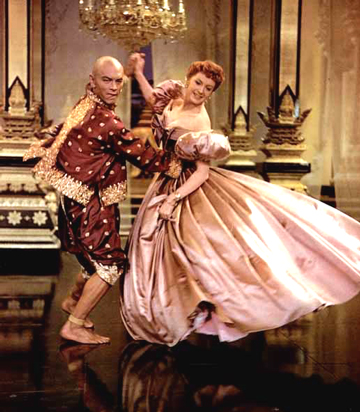
The second (and last) CinemaScope 55 movie is 1956's The King & I, a massive success whose fame has burned bright for half a century. This time the solid source material was didn't need sanitizing either for the stage or screen; as seen in the popular Irene Dunne / Rex Harrison picture Anna and the King of Siam, the hints of a hot 'n' heavy romance between an English schoolteacher and an Indo-Chinese King remain in the censor-safe theoretical stage.
The story is sound in all departments. The proud Anna Leonowens (Deborah Kerr, playing another sexually suppressed role) and her son have a rough time adjusting to work teaching the many children of King Mongkut of Siam (Yul Brynner and his famously bald pate). Although a lively personality, the King's deeply rooted convictions place everyone under his paternal tyranny. Women are chattel and Anna's educated foreigner is only partly an exception. The friendship between sovereign and teacher grows until, in a private meeting in a vast royal reception room, she teaches him to dance the Polka. The major subplot sees Mongkut cruelly separating and punishing two of his 'possessions'. Tuptim (Rita Moreno) is one of his wives, gifted to him by another monarch. Lun Tha (Carlos Rivas) is a worker who brought Tuptim to Siam. They fall in love but under Mongkut's system of bondage have no rights. Anna tries to diplomatically leverage Mongkut's affections to help Tuptim, and to this end stages a Siamese version of "Uncle Tom's Cabin" as a royal entertainment.
Except for some palace exteriors and a street scene The King & I is entirely stage-bound, which is no disadvantage at all thanks to the marvelous designs of John DeCuir. The fact that the vision of Siam is a dated stage construction also means little, as what we see is so visually pleasing. The design really comes forward in the bravura "The Small House of Uncle Thomas" ballet, where costumes and masks convert Harriet Beecher Stowe's drama into a Siamese fable. As the representative of Western decorum, Anna glides through scenes in giant skirts that disguise the fact that she has legs. The contrast with the sensually costumed Eastern women couldn't be greater.
Yul Brynner dominates the movie in the role that both made and capped his career; he'd be performing The King off and on until his death decades later. As for Anna, if Irene Dunne hadn't been too aged for the part she could have performed Anna and sung for her too, instead of being dubbed by Marni Nixon as was Deborah Kerr. Refined, opulent and romantic -- but minus messy sex complications -- Kerr's Anna is the one that's remembered, and the role that most types her career. She and Yul Brynner were considered such a hot pairing that MGM quickly reunited them in the Cold War thriller The Journey.
As with Carousel, the transfer of The King & I has some odd color choices. Most scenes are dazzlingly good, especially the Uncle Thomas ballet, but a great many moments look too blue. We understand seeing a blue tinge in night scenes or the stage performance, but normal close-ups of Deborah Kerr will suddenly turn bluish, even in the middle of a scene. It can only be attributed to the condition of the elements. The 4.0 stereo audio has no deficiencies. Mixed much like Carousel, voices and sound effects come across as directional, appropriate for a classic '50s stereo mix.
Michael Portantiere and Richard Barrios contribute the informed and lively commentary for The King & I, and another track contains a two-channel stereophonic Isolated music score. Five featurettes cover the history of the film and play, the story of the stage version, a quick look at Darryl Zanuck's promotions for CinemaScope, the genesis of the music and a ten-minute overview of the creative teaming of Rodgers and Hammerstein.
A half-hour pilot is present for an Anna and the King TV show, with a commentary by its Anna, Samantha Eggar. An extra audio song is present, plus TV excerpts from the stage version with Patricia Morison and Yul Brynner. Roughly ten minutes of The King & I- related newsreels are offered as well. Finally, a restoration extra gives us an idea of the huge volume of work required to remaster The King & I from original CinemaScope 55 materials.
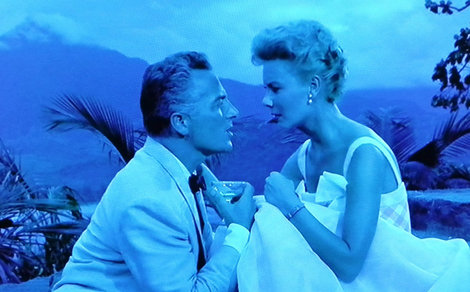
This brings us to an R&H film musical in which the screen purposely changes colors, 1958's South Pacific. Another huge success, the movie had to wait out a particularly lengthy Broadway run so that the film version could be made. The Savant review for the 2009 50th Anniversary Blu-ray of this picture is here. The two discs included in this new set are identical to the earlier release, so I will refer readers to that review for all but a few comments.
We're still impressed that Fox went to the trouble to reconstruct the movie's longer (fifteen minutes!) Road Show version. Even though the sound quality isn't as rich and the added footage is pale and faded (it's presumably a surviving positive print) we're grateful to see the extra story detail and additional scenes.
We're still not sure about the film's color experiment, which still seems a simpleminded attempt to visually suggest moods normally achieved through sensitive direction. But some of the tints work well, especially when the color-wheel seams don't show. The ever-changing mystery matte paintings of the fantasy island Bali Ha'i look even better when cast in different hues. But Joshua Logan's overall direction is numbingly flat, letting his locations and the stage-like blocking do all the work.
South Pacific is billed as filmed in Todd- AO, but this time the 30 frames-per-second film speed was dropped, leaving Oklahoma! and Around the World in 80 Days as the only movies shot in the original Todd-AO format. According to author-authorities Carr and Hayes, the cameras actually used Panavision lenses, which means that the film is really a standard 65mm production.
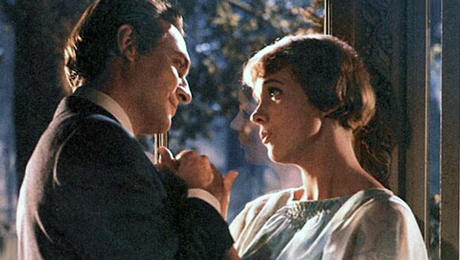
The biggest R&H hit of all, one of the most popular movies of the 1960s and a triumph for director-producer Robert Wise, The Sound of Music was restored several years ago after a complex 8K scan job, and released as a 45th Anniversary Special Edition Blu-ray. Savant didn't review that disc, which I am informed is repurposed here without changes. I did devote a lengthy review to a previous DVD special edition, which details my mixed feelings about the show and the movie, and is amended with some excellent and insightful reader mail. For purposes of general discussion, Savant's previous review of The Sound of Music is here.
The transfer is worth a little discussion of its own. Four years ago at an industry film restoration convention, Fox treated the attendees (and lucky hangers-on, of which Savant was one) to a rare comparison test. In the Linwood Dunn Theater at the Academy's facility on Vine Street, they first projected a reel from The Sound of Music in restored 70mm. It's difficult to believe that any video could possibly approach the detail and clarity of the 70mm we saw; the only movie I've ever seen that was more impressive in a big format was David Lean's Ryan's Daughter. Then they put up an uncompressed 4K theatrical video projection master of the same Sound of Music scene. Any loss in sharpness -- and I'm not saying there was any -- was compensated for by the rock-steady picture and total absence of flicker. I had to admit that the digital projection was better overall -- and no delicate film print would be worn down with each screening.
On this home video Blu-ray The Sound of Music looks marvelous, with the resolution just good enough to convey the eye-popping clarity remembered from theatrical screenings. Color throughout is quite accurate. Although I would argue that the movie is still a big slab of cloying kitsch, it couldn't be more attractive or sound better. And who do we cynics realists think we are, to argue with millions of satisfied customers?
The extras for The Sound of Music lead off with an interactive picture-in-picture feature that looks to have been very costly. It puts a choice of several trivia-track choices on the screen, or all of them at once if you so wish. One is a karaoke feature. It all sounds like a perfect arrangement for viewers incapable of doing one thing at a time.
Robert Wise contributes one commentary, and a second track gathers statements from Julie Andrews, Christopher Plummer (a good sport, despite his put-downs of the movie over the years), Charmian Carr, choreographer Dee Dee Wood and Johannes von Trapp. Like the other titles, this disc also contains the four viewing modes -- "music machine", "sing along", etc.
Accessed through the web is a four-minute piece with Laura Benanti, an actress in a recent Broadway revival of the show.
This new set does not contain the second DVD disc included on the earlier Sound of Music Blu-ray release. It packed in literally dozens of short featurettes on the film, the play, the movie, the story of the Von Trapps and the story of Rodgers & Hammerstein. Fans with the older Blu-ray might want to hang onto it, if they're fond of all those extras, which included featurettes and full-length documentaries over an hour in duration, accessing every bit of publicity material and film shot on location.

Twentieth Century Fox Home Entertainment's Blu-ray of The Rodgers & Hammerstein Collection is one of those monster sets that a number of years ago would come in a gift box not likely to fit on the average bookshelf. We instead get all eight discs packed into a tidy package not much fatter than one for a standard DVD. As if finally aware that few discs are sold from store shelves any more, the package layout gives a minimum of information about the discs inside.
For confirmed Rodgers & Hammerstein musical fans, the big draw here is going to be the marvelous 30 fps Todd-AO version of Oklahoma! The transfers of South Pacific and The Sound of Music are just as good, but the higher frame rate makes Oklahoma! pop out as brighter and clearer -- we're just being hit with more information per second, and the fast motion in the dance sequences is much less blurred. I think of myself at age five, spinning 45rpm records of these songs on the floor, and find it hard to believe that I now can see presentations of the whole movies, in quality probably the equal of what I once saw in theaters.
On a scale of Excellent, Good, Fair, and Poor,
The Rodgers & Hammerstein Collection Blu-ray
rates:
Movies: Good to Excellent
Video: Excellent
Sound: Excellent
Supplements: yes, quite a few -- they're delineated above.
Deaf and Hearing-impaired Friendly?
YES; Subtitles: English, French, Spanish
Packaging: Eight Blu-ray discs in extra-thick keep case in card sleeve
Reviewed: May 18, 2014

Text © Copyright 2014 Glenn Erickson
See more exclusive reviews on the Savant Main Page.
The version of this review on the Savant main site has additional images, footnotes and credits information, and may be updated and annotated with reader input and graphics.
Return to Top of Page
|

